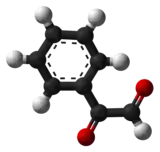Phenylglyoxal
Phenylglyoxal is the organic compound with the formula C6H5C(O)C(O)H. It contains both an aldehyde and a ketone functional group. It is yellow liquid when anhydrous but readily forms a colorless crystalline hydrate. It has been used as a reagent to modify the amino acid, arginine.[2] It has also been used to attach chemical payload (probes) to the amino acid citrulline[3] and to peptides/proteins.[4]
 | |
 | |
| Names | |
|---|---|
| Preferred IUPAC name
2-Oxo-2-phenylacetaldehyde | |
| Systematic IUPAC name
2-Oxo-2-phenylethanal | |
| Other names
Phenylglyoxal 1-Phenylethanedione | |
| Identifiers | |
3D model (JSmol) |
|
| ChEMBL | |
| ChemSpider | |
| ECHA InfoCard | 100.012.761 |
| EC Number |
|
PubChem CID |
|
| RTECS number |
|
| UNII | |
CompTox Dashboard (EPA) |
|
| |
| |
| Properties | |
| C8H6O2 | |
| Molar mass | 134.13 g/mol (anhydrous) |
| Appearance | yellow liquid (anhydrous) white crystals (hydrate) |
| Density | ? g/cm3 |
| Melting point | 76 to 79 °C (169 to 174 °F; 349 to 352 K) (hydrate) |
| Boiling point | 63 to 65 °C (145 to 149 °F; 336 to 338 K) (0.5 mmHg, anhydrous) |
| forms the hydrate | |
| Solubility in other solvents | common organic solvents |
| Hazards | |
| Occupational safety and health (OHS/OSH): | |
Main hazards |
toxic |
| GHS labelling:[1] | |
 | |
| Warning | |
| H302, H315, H319, H335 | |
| P261, P264, P270, P271, P280, P301+P312, P302+P352, P304+P340, P305+P351+P338, P312, P321, P330, P332+P313, P337+P313, P362, P403+P233, P405, P501 | |
| Related compounds | |
Related aldehydes |
3,4-Dihydroxyphenylacetaldehyde |
Related compounds |
benzil glyoxal acetophenone |
Except where otherwise noted, data are given for materials in their standard state (at 25 °C [77 °F], 100 kPa).
Infobox references | |
Properties
Like some other aldehydes, phenylglyoxal polymerizes upon standing, as indicated by solidification of the liquid. Upon heating, this polymer "cracks" to give back the yellow aldehyde. Dissolution of phenylglyoxal in water gives crystals of the hydrate:
- C6H5C(O)COH + H2O → C6H5C(O)CH(OH)2
Upon heating, the hydrate loses water and regenerates the anhydrous liquid.
Preparation
Phenylglyoxal was first prepared by thermal decomposition of the sulfite derivative of the oxime:[5]
- C6H5C(O)CH(NOSO2H) + 2 H2O → C6H5C(O)CHO + NH4HSO4
More conveniently, it can be prepared from methyl benzoate by reaction with KCH2S(O)CH3 to give PhC(O)CH(SCH3)(OH), which is oxidized with copper(II) acetate.[6] Alternatively, it can also be prepared by oxidation of acetophenone with selenium dioxide.[7]
References
- "Phenylglyoxal". pubchem.ncbi.nlm.nih.gov. Retrieved 27 December 2021.
- Kenji Takahashi (1968). "The Reaction of Phenylglyoxal with Arginine Residues in Proteins". J. Biol. Chem. 243 (23): 6171–9. doi:10.1016/S0021-9258(18)94475-3. PMID 5723461.
- Bicker KL, Subramanian V, Chumanevich AA, Hofseth LJ, Thompson PR (2012). "Seeing citrulline: development of a phenylglyoxal-based probe to visualize protein citrullination". J Am Chem Soc. 134 (41): 17015–8. doi:10.1021/ja308871v. PMC 3572846. PMID 23030787.
- Thompson DA, Ng R, Dawson PE (2016). "Arginine selective reagents for ligation to peptides and proteins". J Pept Sci. 22 (5): 311–9. doi:10.1002/psc.2867. PMID 27005702. S2CID 35028264.
- H. von Pechmann (1887). "Zur Spaltung der Isonitrosoverbindungen". Chem. Ber. 20 (2): 2904–2906. doi:10.1002/cber.188702002156.
- Mikol, G. J.; Russell, G. A. (1973). "Phenylglyoxal". Organic Syntheses.; Collective Volume, vol. 5, p. 937
- Riley, H. A.; Gray, A. R. (1943). "Phenylglyoxal". Organic Syntheses.; Collective Volume, vol. 2, p. 509